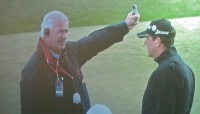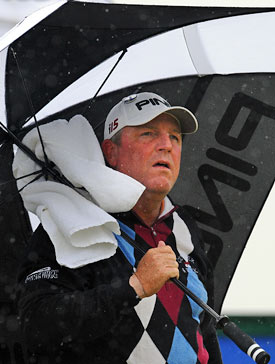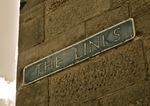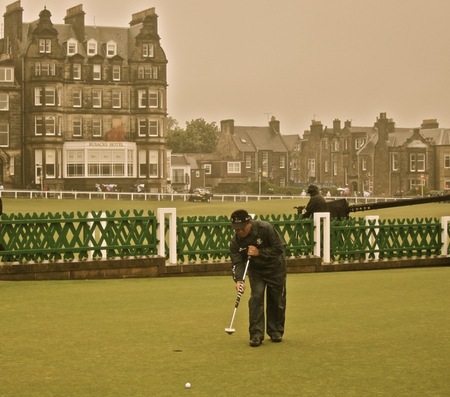 It's old news by now that the morning and afternoon draws saw radically different golf courses. I was out in the afternoon following some players, and I also parked behind the 7th and 11th greens, one of the best places in golf to see any action. The contrast in conditions was extreme to say the least, with the course a par 69 or so in the morning and playing to its normal par or even a stroke higher in the afternoon. The forecast is for the morning wave to get some lousy conditions early, but hopefully they won't and it'll balance out.
It's old news by now that the morning and afternoon draws saw radically different golf courses. I was out in the afternoon following some players, and I also parked behind the 7th and 11th greens, one of the best places in golf to see any action. The contrast in conditions was extreme to say the least, with the course a par 69 or so in the morning and playing to its normal par or even a stroke higher in the afternoon. The forecast is for the morning wave to get some lousy conditions early, but hopefully they won't and it'll balance out.
Tom Watson summed it up nicely if not a tad chauvinistically in this story by Miles Evans:
"She didn't have her clothes on today," the five-times champion said after carding a one-over 73, kicking himself that he failed to capitalise on the flat calm conditions.
"She was ripe for low numbers and that's what happened out there today."
Obviously McIlroy's round is a record until Monday when the new 17th tee is re-abandoned, but it'll be a handsome record to hold for the next 72 hours. I don't care how soft the course is, anytime you can get around here in that it's stupendous golf.
John Daly's post round press conference was entertaining, though not in the way you'd imagine. He's so soft spoken and clearly humbled, as Jeff Babineau notes:
He’s 44 now, and going anywhere that offers a tranquil respite from his often tumultuous and sometimes soap-opera life is a welcome trip for Daly. He has battled alcoholism, depression, exhaustion, a six-month PGA Tour suspension in 2009, a foursome of divorces, sponsorship and financial woes, weight problems, a rib injury and lost status on the PGA Tour. His latest legal tango is with the IRS over back taxes owed – according to recent reports, he owes more than $1 million – but Daly said he’s busily trying to work it all out. It doesn’t help that endorsement checks that once arrived with six zeroes attached no longer find his mailbox.
Steve Elling tells us about the sense of destiny Daly is feeling:
Peter Alliss, the venerable and mirthful British golf broadcaster, actually picked Daly to win in a story published Thursday in the Scottish Sun, a spicy tabloid. It either makes him look like a lunatic or a genius, though with Daly, the line often blurs. Especially at the Old Course, where Daly finished 15th in the last visit in 2005.
"He just knew it," Cladakis said of the aura. "He just feels it. Magic."
It helps that the course has always been good to the long hitter, as John Huggan notes in a column defending the course from critics who might be ready to declare it out-of-date.
Oh, all right, there's even more to all those low numbers than even all of the above. Whisper it, but minus the aforementioned wind, the Old Course just isn't that difficult for the really proficient practitioner. It never really has been, as two-time U.S. Open champion Curtis Strange's course record of 62 more than amply indicates. It is, in fact, made up of 17 holes ranging from incredibly easy to pretty straightforward, plus one incredibly tough par-4, the 495-yard Road Hole. And, even more to the point when we are talking about a gathering of the world's very best players, St. Andrews delivers a disproportionate advantage to those able to blast their hot balls beyond even the middle distance.
"St. Andrews really suits the long-hitters, just because of the places they can put the pins," said Scotsman Andrew Coltart, who shot a nifty little 66 in the company of John Daly. "John can attack some of those pins with his lob wedge and pitching wedge, but I can't with my 5-iron or whatever. Where he can fly his ball at the flag, I'm trying to run mine up; that's a lot harder to judge. So it sets up for guys like him."
My time on the joint 7th and 11th greens impressed upon me the incredible precision necessary to make the crossing holes work. Only once did players approaching the 7th not wait until the group on 11 green was finished, and that was because the group of Martin Kaymer, Zach Johnson and Eric Chun were behind. Even more remarkable is the way in which the grandstand galleries know when to applaud and when to hold off out of respect for players on another hole. This explained the tepid applause for Johnson's excellent approach to the 7th. They simply were worried about distracting the player about to go on 11. Great stuff.
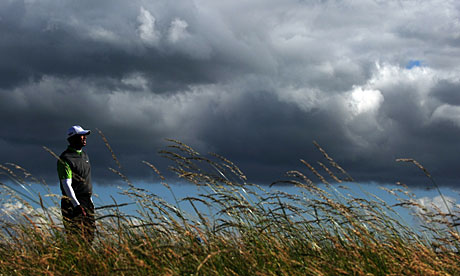 Lawrence Donegan (here) and Steve Elling (here) sum up the player complaints from Friday's second round. They fall into two categories: hole locations and suspending play.
Lawrence Donegan (here) and Steve Elling (here) sum up the player complaints from Friday's second round. They fall into two categories: hole locations and suspending play.

